Kyoto - the magic of Arashiyama Station and the Bamboo Forest
Hola! Hello travelers!
As the cherry blossom period in Japan - the famous sakura - is actually behind us, I decided to extend this pleasant atmosphere a bit and share a story about the famous Arashiyama Station in Kyoto and the nearby Bamboo Forest. Now, with hindsight, I can say that this was the seed of Bamboo Tales. Although I didn't realize it at that time.
A trip to Kyoto is often part of a larger trip around Japan. Nearby Osaka and a quick Shinkasen connection to Tokyo allow you to visit all three cities in 10 days. Kyoto, in my opinion, is the most interesting of those three.
There are several reasons for my rating. Kyoto is the former capital of Japan and the seat of the Emperor. The name of the city literally translates as "capital". The number of palaces and temples spread over 827 km2 is unheard of anywhere else in Japan. The famous Bamboo Forest, known almost all over the world thanks to millions of photos and posts, and the preserved, in perfect condition, city tram line leading to the equally famous Arashiyama Station, are also here. The whole thing is complemented by mysterious stories…
I welcome you to the magical city of Kyoto, where ancient tradition meets modernity. I am taking you on an extraordinary journey by city railway from the city center to the picturesque Arashiyama station, located in the heart of the beautiful Bamboo Forest.
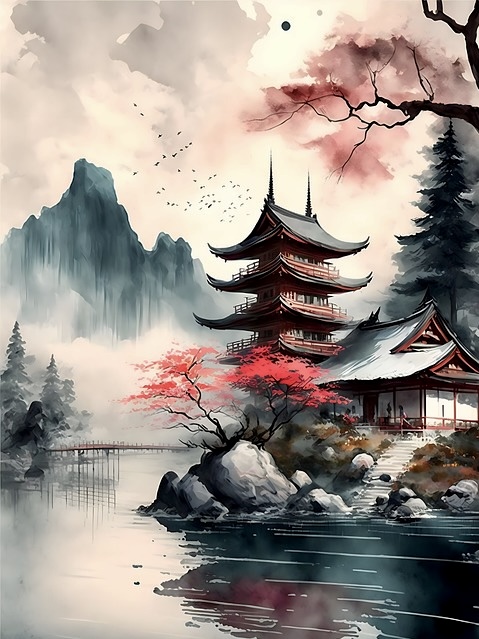
Let's start the day
1. Starting Point: City Center
Our journey begins in the city center, at the Kyoto train station, where within a few minutes' walk we have the station of the historic tram that takes us to Arashiyama. We set off from the bustling Kawaramachi Street, board an air-conditioned carriage and go on a unique journey through the charming corners of the city.
2. Drive through traditional districts
During the first part of the journey, the train passes through the traditional districts of Kyoto, where you will notice picturesque machiya-style houses and numerous temples and Buddhist shrines. The charm of the ancient streets as you move through the city is the essence of Japanese history and culture.
3. Entrance to Arashiyama
Finally, after a dozen or so minutes of driving, we arrive at Arashiyama station. We get off on the platform to greet the green bamboos that rise around the station. At this moment you will feel the magic of this place, which delights with its natural beauty and peace.
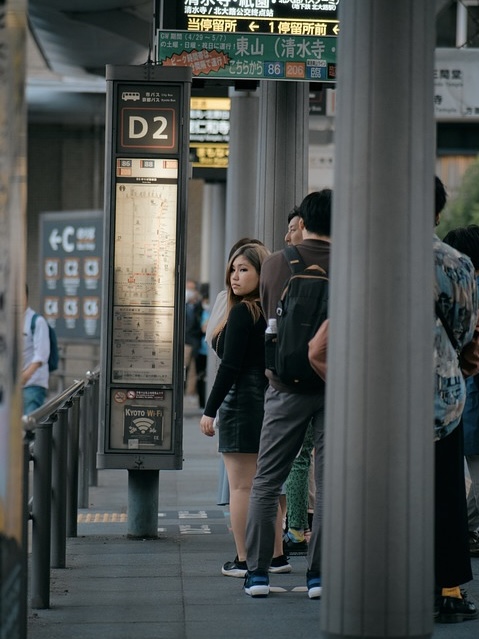
The train runs every 20 minutes, the ticket costs from 80 to 220 yen depending on where you board and what group of travelers you belong to. This is one possible route.
The second is the Sagano Romantic Train - a tourist train that traverses the Hozugawa River Valley, providing breathtaking views of the river, valley and mountains. Panoramic carriages and opening windows will allow you to take quite a rich collection of photos and videos. Especially if you are traveling in spring during Sakura season or in autumn when the leaves of maple trees and plane trees reveal the entire palette of colors known from Polish Masuria. The route is 7.5 km long and the journey takes 25 minutes. At the same time, it is much more expensive - 880 yen per person. I'm planning to go back to Japan and take this train to the bamboo forest.
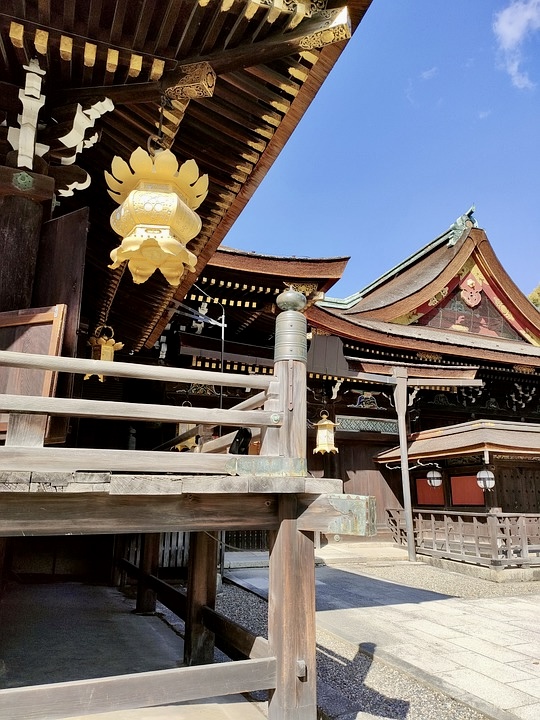
A train is coming from far away...
The train cars going to Arashiyama Station are both functional and aesthetic. They fit perfectly into the character of this charming city and the surrounding nature. What's so special about an "ordinary" light rail car? Well:
1.Traditional Japanese Style: The railway cars in Kyoto are decorated in traditional Japanese style, which makes you feel as if you have traveled back in time to the era of ancient Japan. Their elegant appearance refers to classic Japanese architecture, combining elements of wooden panels and delicate decorations.
2.Panoramic Windows: The carriages are equipped with large panoramic windows that allow you to admire the picturesque views of the passing landscapes. From these windows you can admire the beauty of the traditional houses and streets that pass by as you travel.
3.Comfortable and Spacious Interiors: The interiors of the carriages are arranged in a way that ensures comfort and convenience for travelers. High ceilings and spacious seats allow you to travel in relaxing conditions, and air conditioning ensures a pleasant temperature even on hot summer days.
4.Subtle Cultural Details: The interiors of the carriages are decorated subtly, often using elements of Japanese culture. You can see delicate patterns of sakura flowers or motifs related to classic Japanese engravings, which add charm to the trip.
5.Tourist Information: Inside the carriages there is also tourist information in several languages to help travelers find their way around and learn more about tourist attractions around Arashiyama Station.
All in all, Kyoto's Arashiyama Station train cars are not only a practical means of transportation, but also an integral part of the experience of traveling through this enchanting region of Japan, combining tradition, comfort and natural beauty.

The magic of the station...
Upon arrival, Arashiyama Station will welcome you with a charming mix of traditional and modern architecture. Take a moment to appreciate the intricate design of the station before heading towards the Bamboo Forest.
Arashiyama impresses not only with its functionality, but also with its beauty, which refers to the tradition and culture of Japan, especially kimono clothes.
When entering the station, the first thing that catches your eye is the delicate design that decorates the walls and ceiling. These patterns are an inspiration for traditional kimono patterns, which adds to the charm of this place. From pastel colors to rich patterns of flowers and leaves, every detail of the station is a reminder of the elegance and beauty we associate with kimono outfits. And there is a reason for this. Kyoto is not only the former capital of Japan, but has always been the "capital" of the production of traditional clothing - kimono. Hence the beautiful palisade, in which each column, illuminated at night, represents different styles and patterns of fabrics used to produce kimono.
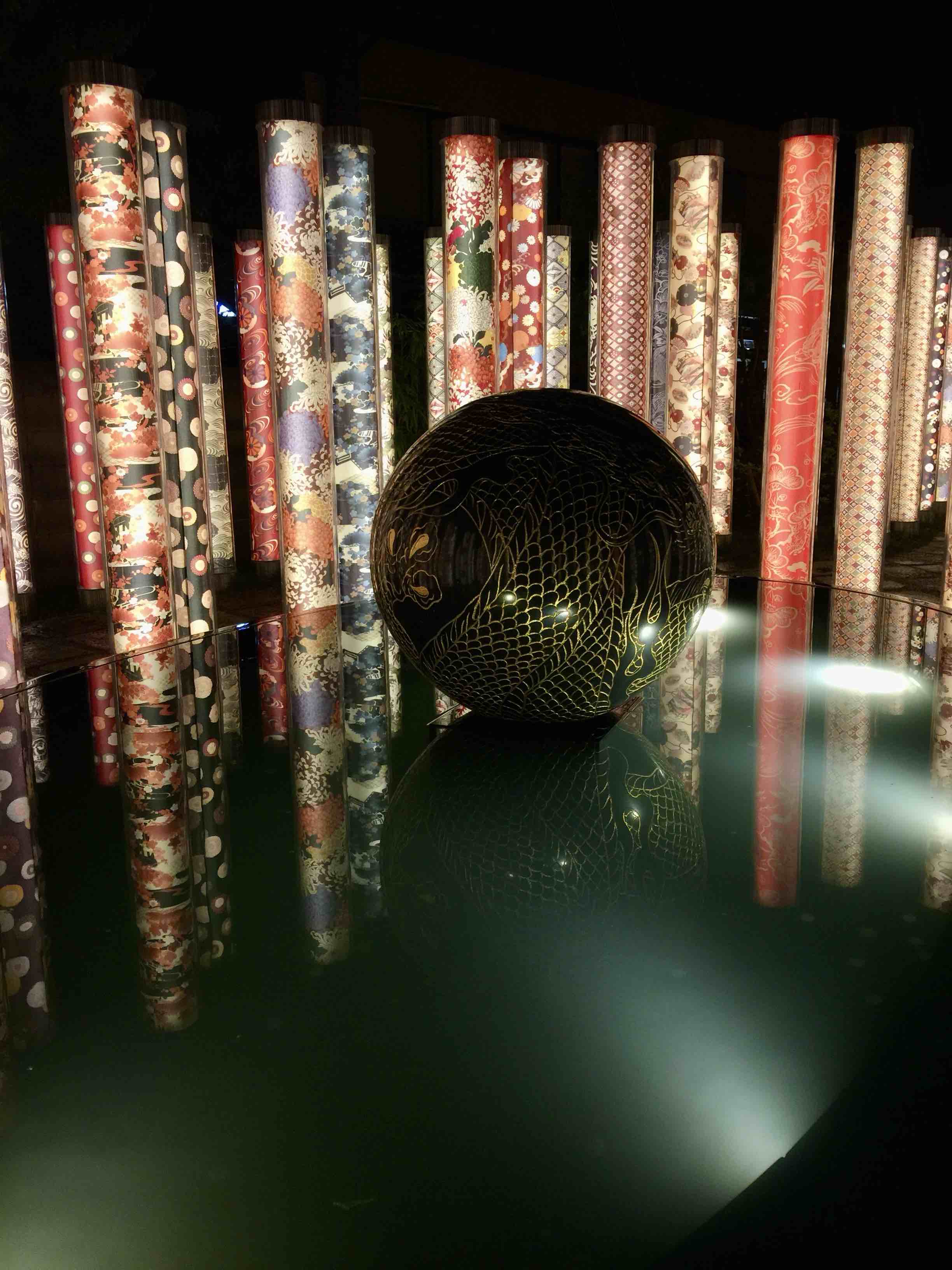
Walking further, you can notice delicate lanterns hanging and illuminating the space with their warm light. These lanterns, known as "chochin", are an integral part of Japanese traditions and are often carried during festivals, adding charm and joy. I see a connection here with the lantern festival celebrated in Southeast Asia.
As we walk further, we come across rest areas where travelers can sit on wooden benches and rest after exploring the bamboo forest, eat lunch or dinner, or wait for the next train to the center. The wood from which the benches are made has a warm, natural color that matches the aesthetics of traditional Japanese houses. You can hear gentle traditional music in the background, which adds charm to the entire atmosphere.
It is also worth paying attention to small details, such as ceramic Geisha figurines that decorate the space or porcelain vases with flowers that add color and elegance to the station. These subtle accents are a tribute to the rich culture and history of Japan, which is constantly present in the everyday life of its inhabitants. On the other hand, tourism is a significant contributor to the city's revenue, so the attention to detail is not surprising.
The magic of the forest...
After leaving the station, I encourage you to explore the area deeper, including the famous Arashiyama Bamboo Forest, which is one of the biggest tourist attractions in Kyoto. Walking along picturesque paths among giant bamboos, you will feel a unique harmony with nature and understand why this place captivates the hearts of visitors so much.
A short walk from Arashiyama Station, along a marked trail, will take you straight to the entrance to a charming forest. As you enter, allow the tall bamboo stalks to create a natural canopy above you, casting captivating patterns of light and shadow. Follow the well-marked walking trails through the forest to immerse yourself in its peaceful atmosphere. The gentle rustle of bamboo leaves in the wind creates a soothing soundtrack as you wander through this breathtaking grove. Look out for special places in the forest, such as the famous Moon Viewing Platform or the picturesque Kameyama Park. These locations offer stunning views and endless photo opportunities. Maps of the entire complex are placed quite frequently and it is easy to choose the right path.
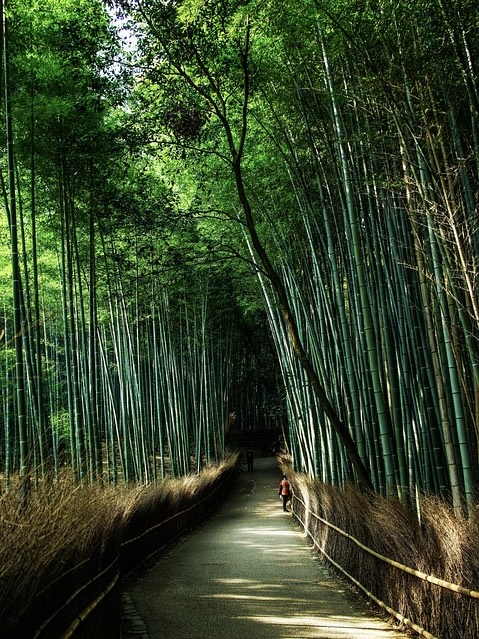
As I mentioned at the beginning, my visit to the bamboo forest was the beginning of my fascination with Asia. I decided to take some time to appreciate the cultural importance of the bamboo forest in Japanese history and art. Bamboo is valued for its strength and flexibility, which symbolizes integrity and resilience in Japanese culture. Additionally, it is one of the best plants from the point of view of a sustainable economy. And so, after some time, the idea for Bamboo Stories sprouted in me.
After exploring the Bamboo Forest, consider sampling local delicacies at nearby restaurants. Enjoy traditional Japanese dishes such as matcha tea, tempura, and sakura mochi to complete your cultural experience in Arashiyama. Before leaving the area, browse the quaint shops near the station for unique souvenirs and gifts. Look for handicrafts, bamboo products or traditional Japanese sweets to take home a piece of the magical Bamboo Forest.
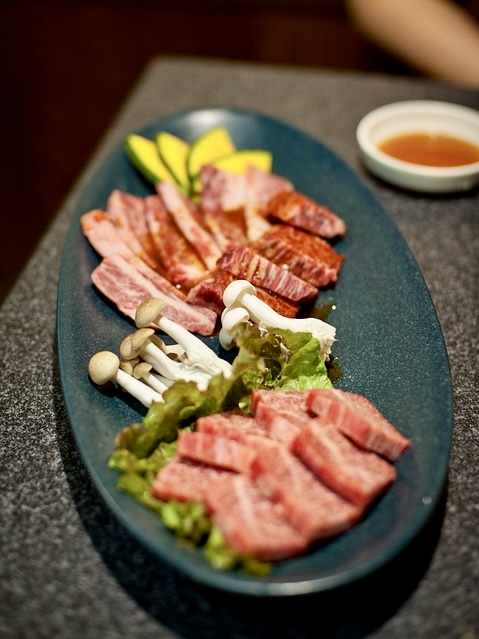
Magical stories...
Arashiyama Station in Kyoto is said to be a place with a rich history and many mysterious stories. One popular story tells of a ghostly figure that supposedly appears on foggy nights, wanders across the platform and disappears into thin air. Locals believe it is the spirit of a samurai who lost his life in a battle that took place centuries ago near the station. Some visitors claim to have seen twinkling lights and heard whispers echoing in the empty tunnels late at night.
Another mysterious story about Arashiyama Station involves a hidden underground passage that is said to lead to a secret chamber beneath the tracks. Legend has it that this chamber contains ancient relics and treasures buried centuries ago by a powerful sorcerer to keep them from falling into the wrong hands. Many brave adventurers tried to discover the passage, but none managed to find the entrance. Some locals claim to have heard faint chanting and whispering coming from deep within the tunnel, adding to Arashiyama Station's eerie mystique. The story continues to intrigue visitors and locals alike, capturing the imagination of those who dare to discover the station's hidden secrets.

There is another mysterious story about Arashiyama Station, which involves a ghostly train that supposedly materializes on the tracks in the middle of the night. Witnesses report seeing a ghostly locomotive enter the station, its windows glowing with eerie light. Passengers dressed in outdated clothes are seen boarding the train, and as the train departs into the darkness, they vanish into thin air. Locals believe that these apparitions are lost souls trapped between the realms of the living and the dead, doomed to repeat their last journey forever. The haunting spectacle of the ghost train has become a source of both fascination and fear for those who visit Arashiyama Station at night.
I like another story. This is the legend surrounding Arashiyama Station, telling the story of a "time portal" hidden within the station. It is said that when the clock strikes midnight on the eve of the full moon, a shimmering gate appears near the platform, inviting the curious to enter another time. Those who dared to enter the portal claim to have been transported to different eras in Kyoto's history, experiencing the sights, sounds and even smells of times gone by. Some even swear that they have met historical figures from long ago during their travels. The existence of this portal remains a well-kept secret, known only to the few who dare to discover the secrets of Arashiyama Station.

Legends of the Bamboo Forest...
But legends and amazing stories do not only concern the station. The bamboo forest also hides secrets.
First story: The mysterious spirit of the bamboo forest
In the Arashiyama bamboo forest, there are stories of a mysterious spirit that wanders the paths between the massive bamboos at night. It is said to be the spirit of an ancient guardian who once guarded these lands. According to legend, once a local fisherman, bored with his life, decided to catch the biggest fish in a nearby pool. On the day of his catch, he relentlessly moved deeper and deeper into the forest to find the perfect fishing spot. Unfortunately, he never returned. Since then, people have claimed that at night they can hear the sound of water and see misty figures moving between the bamboos.
Second story: The phenomenon of enchanted lanterns
During one night in May, a group of tourists decided to take a walk through the bamboo forest, taking advantage of the unique opportunity to visit it after dark. As they walked, they began to notice that the lanterns that were supposed to be their guides began to flicker and go out mysteriously, leaving them in darkness. The silence was broken by the distant sound of a traditional Japanese melody that suddenly began to play somewhere in the distance. They noticed with horror that the melodious sounds led them deeper and deeper into the dense forest. Fortunately, after a few minutes, the sounds suddenly stopped and the lanterns returned to their normal state. The tourists managed to return safely to the city, but to this day they cannot explain what really happened that night.
Third story: The mysterious, lost collection
In one of the remote corners of Arashiyama Station there is an ancient building that has housed a collection of antique items for years. These items were said to have unusual powers and were closely guarded from curious eyes. However, one night, when a storm shook the area, the building was destroyed and the collection disappeared without a trace. Some say the ghosts decided to retrieve their old artifacts because they didn't want them to fall into evil hands. Others believe that hidden somewhere deep in the forest, these extraordinary objects are still waiting for a brave explorer who will find them and discover their secrets.
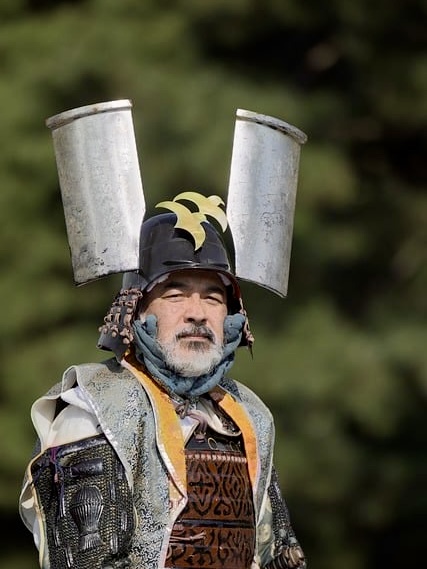
Did these stories give you a thrill?
The bamboo forest and Arashiyama station are places where reality intertwines with myths and legends, creating an extraordinary atmosphere. The mysterious aura of Arashiyama Station adds to its charm and makes it a fascinating place for those intrigued by the supernatural.
After a full day of exploring the charms of Arashiyama and its surroundings, we return to the train station to conveniently return to the center of Kyoto.
To sum up, visiting the Arashiyama train station and visiting the Bamboo Forest is not only a journey from point A to point B. It is also a combination of natural splendor and cultural heritage, learning about the beauty and elegance of traditional kimono clothes and Japanese culture. It is a place that inspires and delights, leaving an unforgettable impression on every traveler who has the pleasure of visiting it. This is a must-see destination for those looking for an unforgettable experience in Kyoto.
When night falls on Arashiyama and the moon illuminates the paths between the tall bamboos, an extraordinary journey begins... and that's what I wish you. Have an amazing journeys!
More articles


Pages created with WebWave




















